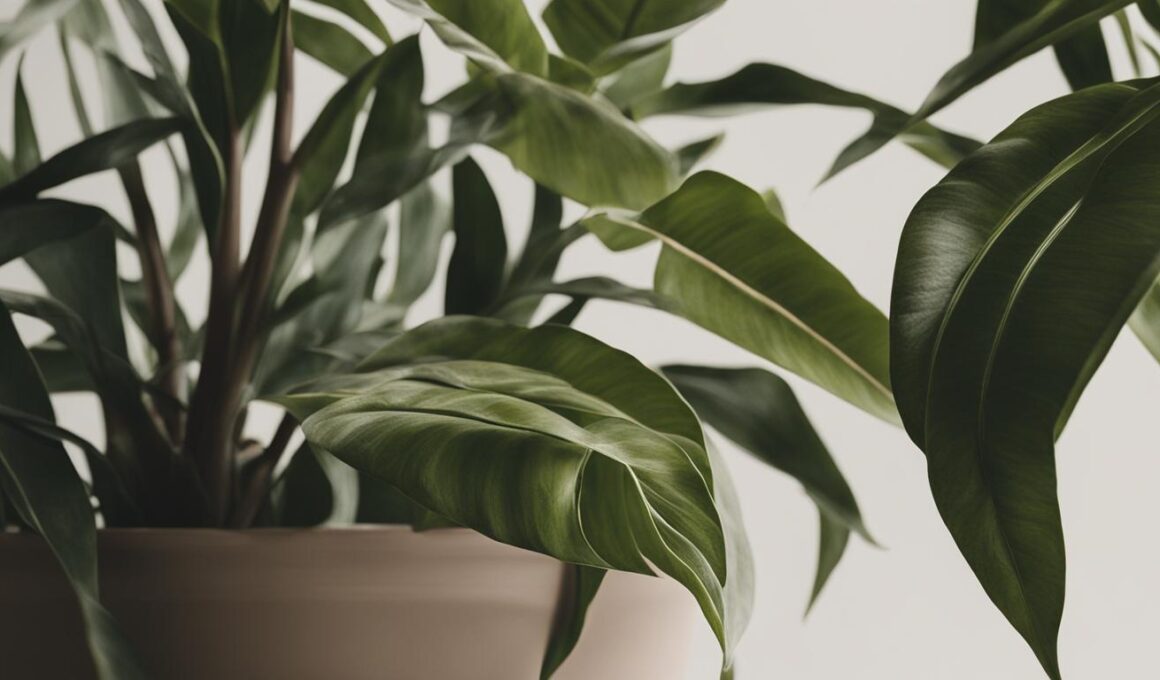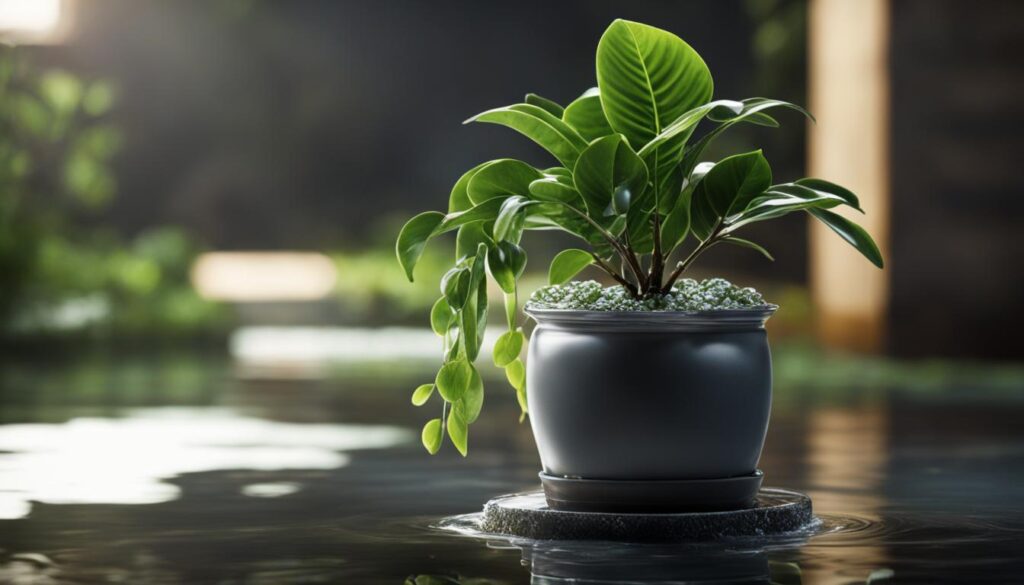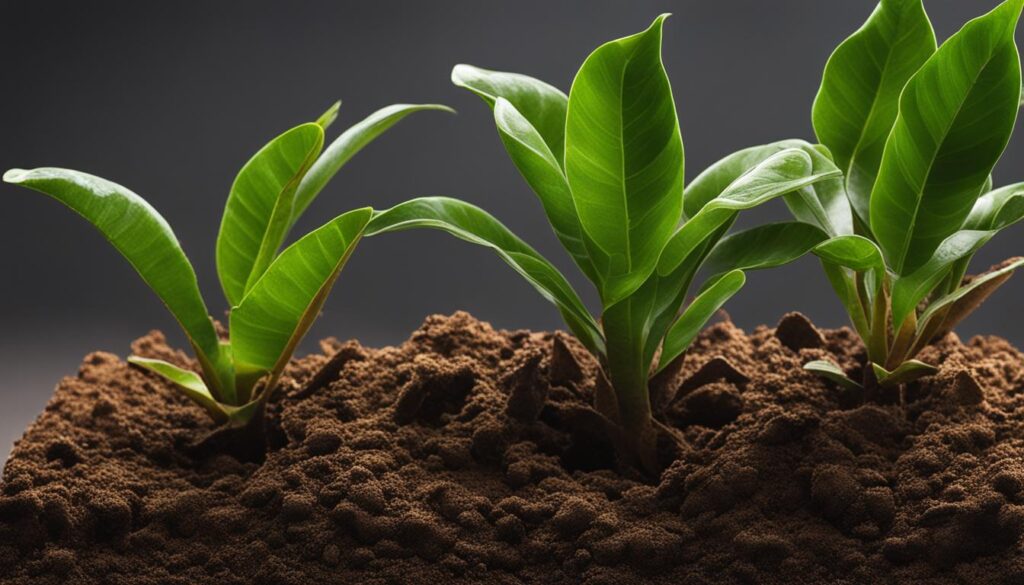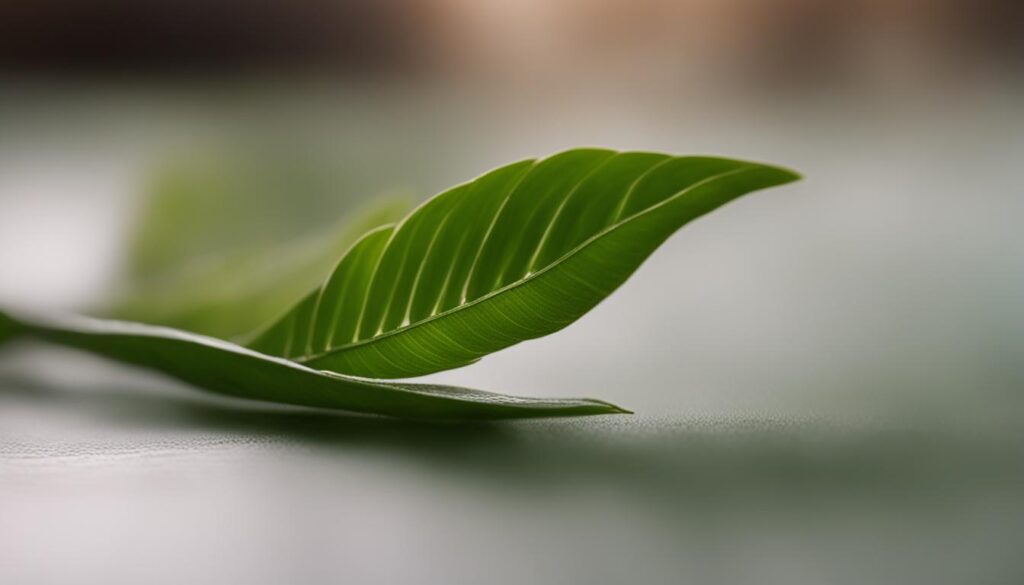ZZ plant leaf discoloration can be a source of worry for plant enthusiasts. This common houseplant is known for its lush, green foliage, but sometimes its leaves may turn brown, drawing concern. The causes of brown leaves can vary, with some potential culprits including improper watering schedules, tap water chemicals, and insufficient humidity. However, understanding the underlying issues and applying the proper remedy for brown ZZ plant leaves can help restore the plant to optimal health.
Key Takeaways
- Incorrect watering schedules are a leading cause of brown ZZ plant leaves.
- Tap water chemicals, such as chlorine and fluoride, can contribute to leaf burn.
- Low humidity levels may lead to leaf browning in ZZ plants.
- Effective remedies include pruning damaged leaves, adjusting watering schedules, and improving humidity conditions.
- Proper plant care is crucial in preventing brown leaves and maintaining overall ZZ plant health.
Introduction to the Resilience and Care of ZZ Plants
The ZZ plant (Zamioculcas zamiifolia), native to East Africa, is a hardy, resilient houseplant that remains quite low maintenance when given proper care. Despite its natural toughness, issues such as brown leaves may signify an underlying problem. Achieving the correct balance of ZZ plant care involves attentiveness to water needs, proper water quality, and maintaining ideal humidity levels, which help keep these lush, green plants healthy. The following sections will discuss these factors in detail, providing you with essential knowledge for successful Zamioculcas zamiifolia maintenance.
Before diving into specific care practices, it’s crucial to have a general understanding of the ZZ plant’s hardiness. When compared to other common houseplants, the ZZ plant is notable for its resilience.
In the table below, you can see how the ZZ plant’s care requirements compare to other popular houseplants:
| Houseplant | Water Frequency | Light Requirements | Humidity Tolerance |
|---|---|---|---|
| ZZ Plant (Zamioculcas zamiifolia) | Every 2 weeks | Low to bright indirect light | Low to moderate |
| Peace Lily (Spathiphyllum) | Every 1-2 weeks | Low to medium indirect light | High |
| Fiddle Leaf Fig (Ficus lyrata) | Every 1-2 weeks | Bright indirect light | Moderate to high |
| Aloe (Aloe vera) | Every 3 weeks | Bright indirect light | Low |
As evident from the table, the ZZ plant’s care requirements are comparatively lenient, making it a popular choice for beginners and those with busy lifestyles. However, resilience should not be taken for granted. The right balance of water, light, and humidity is essential for the plant’s long-term health.
In the following sections, we’ll explore the primary factors contributing to brown leaves on ZZ plants, such as over-watering, water quality, humidity levels, and improper watering schedules. By understanding these factors, you’ll be better equipped to prevent future leaf discoloration and ensure the health and beauty of your ZZ plant.
Over-Watering: The Primary Culprit for Brown Leaves
One common problem that can lead to brown tips on leaves of your ZZ plant is over-watering. When a ZZ plant receives too much water, the leaf tips become soft and mushy, eventually turning brown. This excess moisture can, in turn, cause root rot in plants, which may lead to the death of the plant if not addressed promptly.
To prevent over-watering, it’s essential to adjust your water cadence according to the soil moisture of your ZZ plant. Conversely, under-watering can also cause problems, as evidenced by dry, crispy brown tips on the leaves. To strike the right balance, the optimal watering frequency for a ZZ plant is roughly once every two weeks, allowing the plant to dry out partially between waterings.
Consider the following table to determine the appropriate watering frequency and signs of over- or under-watering:
| Condition | Watering Frequency | Signs |
|---|---|---|
| Under-Watering | Less frequent than recommended | Dry, crispy brown leaf tips |
| Optimal Watering | Every two weeks (adjust based on soil moisture) | Healthy green leaves, no leaf discoloration or texture issues |
| Over-Watering | More frequent than recommended | Soft, mushy brown leaf tips, potential root rot |
By monitoring the signs of over- and under-watering, you can optimize your ZZ plant’s watering schedule and avoid common pitfalls that lead to brown leaves, ensuring a healthy and thriving plant.
Water Quality and Your ZZ Plant: Avoiding Leaf Burn
While ZZ plants are resilient and can tolerate a range of conditions, they can still suffer from brown edges on their leaves, indicative of ZZ plant leaf burn. This issue may stem from the quality of water used to care for the plant.
Using Filtered Water to Prevent Brown Edges
Tap water typically contains chemicals such as fluoride and chlorine, both of which can harm plant tissue and cause leaf burn. Moreover, the minerals in unfiltered tap water can accumulate in the soil, leading to potential toxicity. To prevent ZZ plant leaf burn and ensure the quality of water for ZZ plants, it is essential to make some changes in your watering routine.
- Filtering tap water for your plants is the best option, as it helps remove chemicals and excess minerals.
- Collecting rainwater and using it to water your ZZ plant is not only environmentally friendly but also provides a gentle and chemical-free source of hydration for your plant.
- Leaving tap water out overnight allows the chlorine to evaporate, reducing its harmful effects on your plant. Simply fill a container with tap water, cover it, and let it sit overnight before using it to water your ZZ plant.
By taking these steps to improve water quality for your ZZ plants, you can reduce the chances of leaf burn and ensure the health and growth of your plants. Remember that ZZ plants are resilient, and with a few simple adjustments to their care, they can continue to thrive.
How Improper Watering Schedules Affect ZZ Plants
Both under-watering and over-watering can harm ZZ plant health. A proper ZZ plant watering schedule entails thorough watering until drainage occurs, then allowing the soil to dry significantly before the next watering. Excess water should always be removed to prevent root issues.
Soil moisture level should guide watering frequency to avoid stressing the plant. Not only can over-watering cause problems, but underwatering symptoms can also lead to the plant’s decline. Understanding and identifying these symptoms is critical in maintaining a healthy ZZ plant. Some common underwatering symptoms include:
- Yellowing leaves
- Crispy, brown leaf edges
- Wilting, even after watering
- Stunted growth
Monitoring ZZ plant soil moisture is crucial for providing balanced care to your ZZ plant. The table below highlights the key differences between over-watering and under-watering symptoms and how to address them effectively:
| Watering Issue | Symptoms | Solution |
|---|---|---|
| Over-Watering |
|
|
| Under-Watering |
|
|
By following a proper ZZ plant watering schedule and keeping an eye on underwatering symptoms, you can ensure your plant remains healthy and vibrant. Remember to also consider factors such as humidity and water quality for the optimal care and maintenance of your ZZ plant.
The Role of Humidity in Keeping ZZ Plant Leaves Green
Humidity plays a critical role in preventing brown leaves in ZZ plants. While they are typically tolerant of average home humidity levels, raising the humidity may be necessary if browning occurs. Regularly misting the leaves, using a humidifier, or employing a pebble tray can create a more humid microclimate conducive to plant health.
Misting and Humidifier Solutions for Dry Environments
For those living in particularly dry environments, regularly misting the leaves of your ZZ plant can help maintain adequate humidity. Misting should be performed consistently to ensure the plant receives the moisture it needs.
Humidifiers provide another effective way to increase humidity in the immediate surroundings of your plants. Investing in a quality humidifier can offer multiple benefits for your plants’ health, creating a lush, green environment that supports their well-being.
Pebble Trays: A Simple Humidity Hack
Pebble trays offer a simple and cost-effective solution to incrementally increase ambient humidity. By placing the ZZ plant pot on a tray filled with water and pebbles, evaporation naturally raises moisture levels around the plant, reducing brown leaf incidence.
To create a pebble tray, simply follow these steps:
- Select a tray with a large surface area that accommodates your ZZ plant pot.
- Fill the tray with a layer of pebbles or small stones.
- Add water to the tray until it reaches just below the top of the pebble layer.
- Place your ZZ plant pot on top of the pebbles, ensuring that the bottom of the pot does not sit directly in the water.
- Replenish water in the tray as needed, generally once every 7 days.
By employing these humidity hacks to your advantage, you can help maintain the vibrant green appearance of your ZZ plant and prevent brown leaves from developing.
Browning Leaf Tips: Could It Be Low Humidity?
ZZ plant browning leaves can be a symptom of low humidity plant problems, especially when it comes to the tips of leaves. Adequate humidity levels are essential for maintaining the vitality of your ZZ plant, and providing a comfortable environment for this resilient houseplant to grow and thrive. If you notice that the leaf tips of your ZZ plant are turning brown, it’s time to consider some methods for fixing brown leaf tips related to low humidity issues.
There are several ways to increase the humidity around your ZZ plant and prevent further browning of the leaf tips:
- Use a humidifier: Placing a humidifier close to your ZZ plant can help increase the humidity within its immediate vicinity. Be sure to choose a humidifier with adjustable settings to achieve the desired humidity level for your plant.
- Water-filled pebble tray: Fill a tray with pebbles and water, placing your ZZ plant pot on top of this tray. The evaporation of water from the tray will create a microclimate of increased humidity around your plant.
- Group plants together: Placing several plants in close proximity can help create a more humid environment through their natural transpiration process. Be mindful of each plant’s individual requirements to ensure they all receive the necessary care.
Monitoring the humidity levels around your ZZ plant and taking appropriate action can prevent further browning of leaf tips. Remember, maintaining a balance between watering, light, and humidity will help ensure the overall health and beauty of your ZZ plant.
Reviving Your ZZ Plant: Steps to Treat Brown Leaves
Bringing your ZZ plant back to optimal health involves addressing the underlying causes of brown leaves and taking appropriate action to remedy the situation. Two essential steps to reviving your ZZ plant include pruning damaged foliage and employing the soak-watering method for proper rehydration.
Pruning Techniques for Damaged Foliage
Properly pruning brown leaves is crucial for maintaining your ZZ plant’s appearance and ensuring its recovery. Completely brown leaves will not revert to their original green color, so removal is necessary. However, it’s essential to prune in stages to avoid plant stress. Follow these guidelines for effectively trimming damaged leaves on your ZZ plant:
- Sanitize your scissors or pruning shears with rubbing alcohol to prevent the spread of disease.
- Remove no more than 20% of the affected foliage at once to minimize shock to the plant.
- Make precise, clean cuts close to the base of the leaf, taking care not to damage surrounding healthy foliage.
- Monitor the plant’s progress, waiting a few weeks between pruning sessions to ensure a gradual recovery.
Soak-Watering Method for Thirsty ZZ Plants
If your ZZ plant suffers from extreme soil dryness, opt for the soak-watering method to ensure even soil moisture and adequate hydration. This technique submerges the plant in water for an extended period, allowing the soil to absorb water thoroughly. Here’s how to effectively rehydrate your plant with the soak-watering method:
- Fill a large container or basin with room temperature water, ensuring it’s deep enough to cover the plant’s base.
- Place the ZZ plant in the water, making sure the soil is entirely submerged, avoiding contact between the leaves and water.
- Allow the plant to soak for 45 to 60 minutes, ensuring the soil absorbs enough moisture.
- Remove the plant from the water and allow it to drain thoroughly to prevent root rot.
- Return the ZZ plant to its regular location and monitor the soil moisture level, adjusting your watering schedule accordingly.
By pruning damaged leaves and using the soak-watering method, you pave the way for your ZZ plant’s recovery and eventual return to lush, green health. Remember to monitor your plant’s progress and make any necessary adjustments to other aspects of its care, such as water quality and environmental humidity, to ensure a successful revival.
Are Brown Tips on Houseplants a Sign of the Same Problem?
If you notice your spider plant tips browning issue, it could be due to various factors such as overwatering, low humidity, or nutrient deficiencies. Adjust your watering schedule, increase humidity around the plant, and consider fertilizing to address the problem.
Conclusion
Ensuring the well-being of your ZZ plant requires addressing the root causes of brown leaves. Through careful observation and assessment, you can effectively prevent brown leaves, maintain ZZ plant health, and achieve optimal plant maintenance. Identifying issues such as water quality, watering frequency, and environmental humidity plays a crucial role in restoring and preserving a lush, green appearance.
It is essential for plant enthusiasts to recognize and understand the signs of stress in their ZZ plants and modify their care practices accordingly. This includes ensuring the right balance between factors such as soil moisture, water quality, and humidity levels. By doing so, you can prevent common pitfalls and ensure your ZZ plant thrives in its indoor setting.
In conclusion, a thoughtful and balanced approach to ZZ plant care goes a long way in preventing issues such as brown leaves. By adopting proper maintenance methods, you can enjoy the thriving, vibrant presence of your ZZ plant for years to come.












